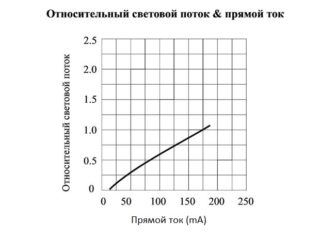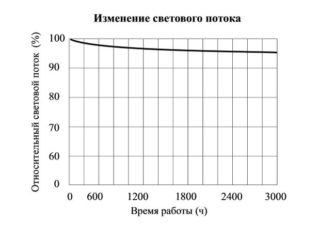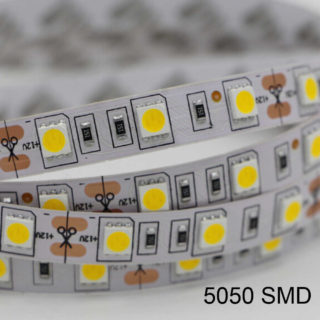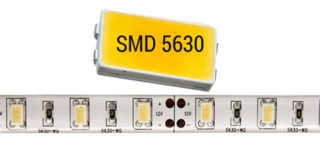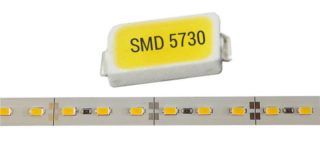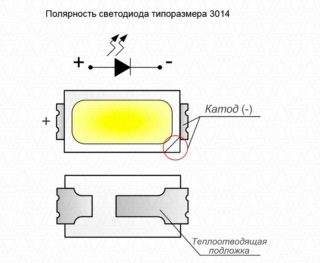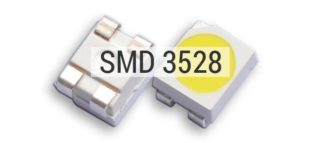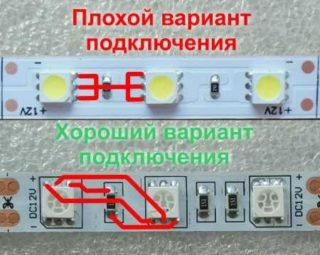LED lighting is based on the ability of semiconductors to convert electrical current into luminous flux. By their purpose, the devices are divided into two groups: indication and lighting. The first type has low power and is used to indicate devices. The second type is installed in lighting fixtures. SMD LEDs are the most common type of lighting fixture.
- What are SMD LEDs
- Manufacturer marking
- LED characteristics
- Consumption current
- Luminous efficiency, angle of illumination, power
- Colorful temperature
- Dimensions and their effect on the properties of LED sources
- Color range
- Description of the main smd LEDs
- SMD 2835
- SMD 5050
- SMD 5630
- SMD 5730
- SMD 3014
- SMD 3528
- Application and connection requirements
- Pros and cons
What are SMD LEDs
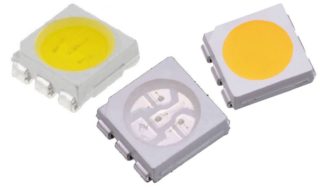
SMD semiconductor devices are called smd LEDs. They differ from other devices in design features. The electronic chip is assembled on a copper or aluminum printed circuit board. A crystal is used as a chip. The surface mount method simplifies the production and reduces the cost of LEDs.
SMD electronic components are characterized by the maximum approximation of the semiconductor to the substrate, which removes heat. To create white light, the crystal is coated with a phosphor layer. The main features of the device:
- high brightness;
- a monochrome crystal emits one color - white, red, blue, yellow;
- consists of one or more crystals;
- modules are able to create lighting with a scattering angle from 100 to 160 °;
- smd diodes operate on constant current.
All semiconductor devices have a long service life.
Manufacturer marking
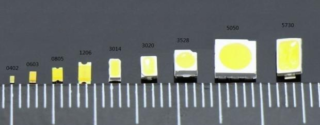
The standard marking of LEDs, the decoding of which gives information about the linear dimensions of the device, is applied by all manufacturers. The digital designation shows the length and width of the LED chip in fractions of a millimeter. In some cases, in addition to the standard size of the case, other parameters are applied - color and power. For example: SMD 2835 UWC 5 - matrix size 2.8 × 3.5 mm, color - white (Ultra White Color), power 0.5 W. There is a special code smd 2l for surface mount electronic components.
LED characteristics
The parameters of the devices affect the possibility of their use in various fields. The main characteristics of products include: voltage, power, angle of illumination, color temperature, luminous flux.
Consumption current
Luminous efficiency, angle of illumination, power
- low power - up to 0.5 W;
- medium - 0.5-3 W;
- large - from 3 W.
The characteristic is necessary when calculating the power supply. It is calculated by the formula - current multiplied by voltage.
The nominal voltage of the diodes is low, it is 1.1-4 V. The value changes due to the difference in colors and materials of electronic components. The white device has the highest voltage.
Colorful temperature
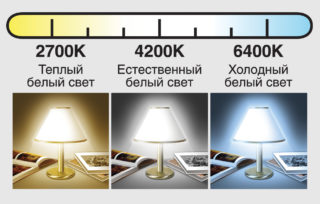
The radiation intensity or color temperature is important for the comfortable perception of illumination by the human eye. There are several categories of white light:
- 2700-3500 - warm;
- 3500-5000 - neutral or day;
- above 5000 - cold.
The color temperature is indicated in Kelvin (K), it is indicated in the marking.
Dimensions and their effect on the properties of LED sources

Depending on the type, the size of smd LEDs changes. The brightness of the elements increases with the size. The glow area can be round or rectangular. The larger the parameter, the brighter the lighting. The light flux also depends on the number of crystals. In different models, there are from 1 to 4 pieces. The power of the device depends on the size of the crystal. The characteristic is indicated by the manufacturer in "mil", 1 mil = 0.0254 mm. For example: 45 × 45 mil chip - 1 W, 24 × 24 mil - 0.5 W.
Color range
LED color depends on semiconductor material and dopants. Primary colors are red, blue, green and yellow. White color is obtained by applying a layer of phosphor on a crystal with blue luminescence. Two-color devices are used for indication. Tricolors are used in displays.
Description of the main smd LEDs
The number of standard sizes of LED lighting sources is constantly increasing. The most widespread are several types.
SMD 2835
- current - 60, 150, 300 mA;
- power - 0.2, 0.5, 1 W;
- light flux - 20-100 lm.
The body is made of a heat-resistant polymer designed for heating up to 240-260 °. The emitting area is rectangular, covered with a phosphor.
SMD 5050
- the total current is - 0.02 × 3 = 0.06 A;
- power - 3 × 0.7 = 0.21 W;
- Luminous flux - 18-20 lm.
The chip is capable of emitting all shades of white, blue, red, yellow, green or RGB tri-color. Used in flexible tapes, lamps. Adjustment of the glow mode is possible.
SMD 5630
- rated current - 0.1-0.15 A;
- luminous flux - 32-57 lm;
- voltage - 3-3.6 V.
To exclude overheating of the crystal, the chip is mounted on an aluminum substrate. The device is used in street and industrial lighting.
SMD 5730
- rated current - 0.15.0.18 A;
- power - 0.5-1 W;
- luminous flux - 45 lm.
The illumination angle is 120 °. The device is resistant to vibration, moisture, and has a long service life.
SMD 3014
- voltage - 2.7-3.3 V;
- current - up to 0.3 A;
- glow - 9-11 lm.
The devices give all shades of white light.
SMD 3528
- operating current - 0.2-0.25 A;
- voltage - 3-3.2 V;
- luminous flux - up to 7 lm.
The brightness of the model depends on the temperature; an increase in the parameter leads to accelerated degradation of the crystal. At 75-80 °, the device shines 25% weaker.
Application and connection requirements
Applications for LED devices include residential, commercial and outdoor lighting. Depending on the dimensions of the smd, the LEDs are placed in lamps or strip illumination. Several chips on the board replace standard incandescent bulbs and energy-saving fluorescent bulbs. Devices with a wide illumination angle are used in floodlights.LED arrays have replaced bulbs in flashlights, headlights, signposts, traffic lights and signage.
The polarity must be observed when connecting the LEDs. For stable and long-term operation, a separate resistor is connected to each chain of series-connected LEDs. The power supply must provide a voltage higher than the sum of all the chips.
Pros and cons
- wide scope;
- long service life;
- vibration resistance;
- economical consumption of electricity;
- operation at low temperatures;
- instant start of the lighting fixture.
The disadvantages of electronic components include:
- sensitivity to heat;
- high cost of quality products;
SMD LEDs are effective sources of main lighting and decorative lighting. A variety of elements allows you to choose the best option in terms of power, brightness and color.

